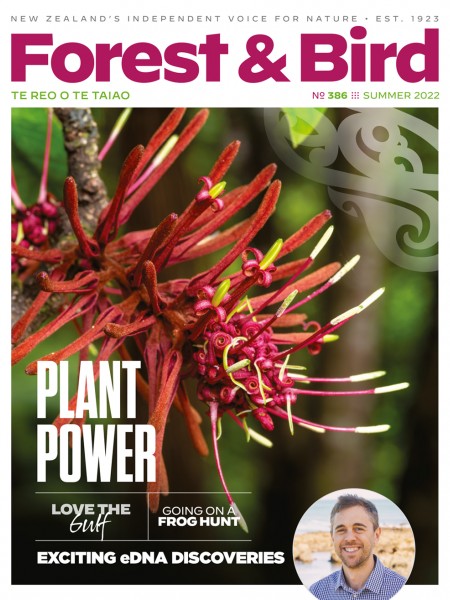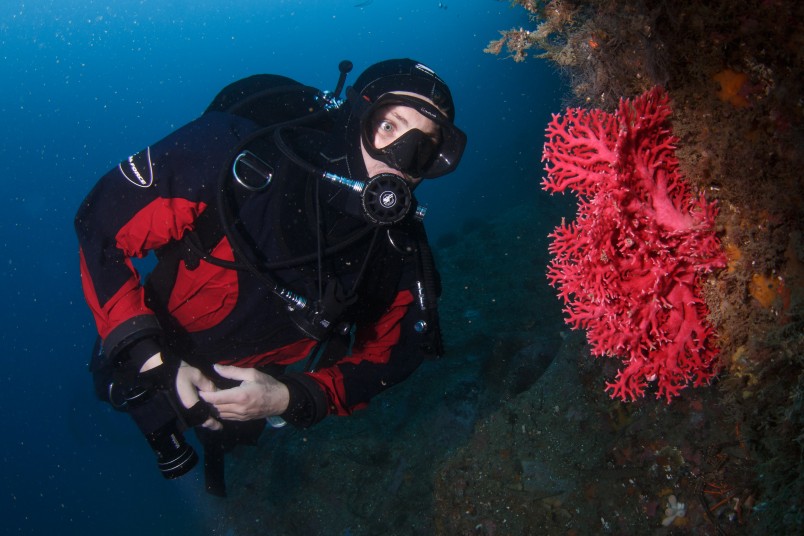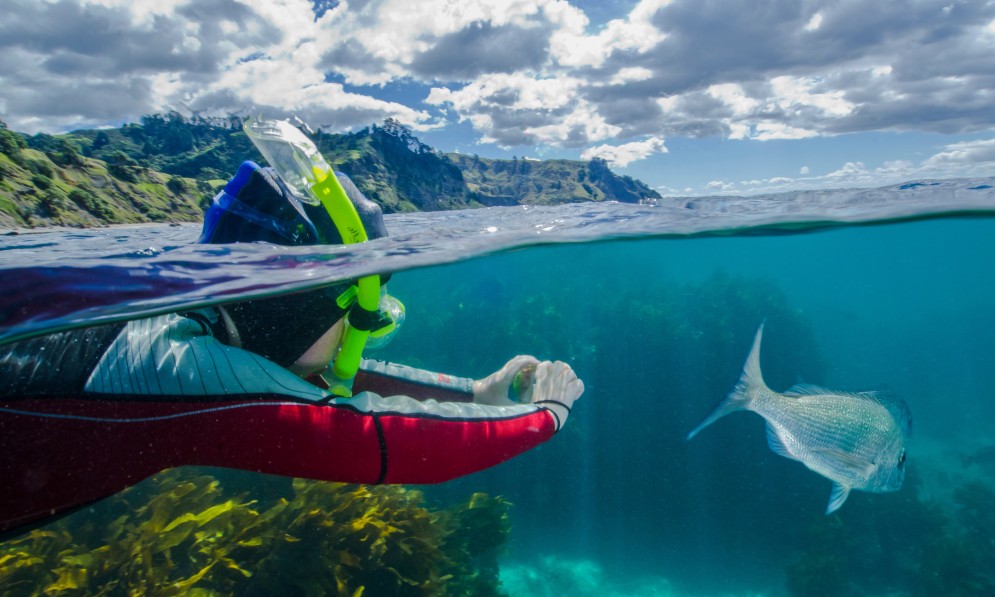Here is our guide to some of the top family-friendly snorkelling and diving spots in Aotearoa. By Kathryn Curzon
You are never far from the ocean in New Zealand, and we have some outstanding diving and snorkelling spots, but few people know about them. New Zealand boasts more than 15000km of coastline and around 600 islands, hosting everything from subtropical islands to cold, dramatic fiords. Read on to discover some of the top family-friendly places to get in the water this summer and explore what lies below.
RAINBOW WARRIOR, CAVALLI ISLANDS
Forest & Bird magazine
A version of this story was first published in the Summer 2022 issue of Forest & Bird magazine.

Just 10 minutes by boat from Matauri Bay in Northland lies the Greenpeace flagship Rainbow Warrior. This vessel is the most famous wreck in New Zealand and is a vibrant artificial reef. It is covered in pink and orange jewel anemones and surrounded by demoiselles and blue maomao. This stunning wreck sits at around 26m deep in mild currents and is an excellent wreck for advanced divers. Dive trips to Rainbow Warrior with Pahia Dive usually consist of a wreck dive, a beach lunch, and reef snorkelling, making it a perfect trip for the entire family.
CAPE BRETT PENINSULA, BAY OF ISLANDS
While the famous HMNZS Canterbury is the most sought-after dive around the Cape Brett Peninsula, there is plenty for non-divers to enjoy in this fascinating area. The reefs of Deep Water Cove are stunning, having been a marine reserve since 2010, and are full of life. There are healthy kelp beds dotted with sponges and numerous fish species in these sheltered, calm waters. Around the peninsula, there are also boulder landscapes, an impressive swim-through, and shallow fish nurseries to explore.
POOR KNIGHTS ISLANDS, TUTUKAKA
If you only go diving or snorkelling in New Zealand in one place, make it the Poor Knights Islands. These world-famous islands offer an exciting mix of subtropical and temperate species, and they were rated as one of the world’s best dive spots by Jacques Cousteau. There are numerous landscapes to enjoy, including rocky boulders and sunlit kelp forests. More than 125 fish species are found in these rich waters, plus soft corals, sponges, stingrays, and huge schools of fish. In summer, manta rays, sea turtles, and even orca visit the islands.
GREAT BARRIER ISLAND, AUCKLAND
Further south, Great Barrier Island and its neighbour Little Barrier Island boast hammerhead sharks during the summer months. But even if you don’t see hammerheads, there are shallow reefs busy with fish life and sheltered waters that are ideal for first-time snorkellers.
GOAT ISLAND, LEIGH
If you have time while you’re visiting Auckland, take a detour to Goat Island at Leigh. This was New Zealand’s first marine reserve and is a rich marine ecosystem with some of New Zealand’s best snorkelling. The Auckland area is also a great place to get your first dive certification. There are dozens of dive sites close to shore and a handful of excellent dive centres to choose from.

Red coral in Piopiotahi Milford Sound Marine Reserve. Image Grant Thomas, Descend Diving
THE MERCURY ISLANDS, COROMANDEL
The Coromandel Peninsula is famed for its islands and soft white sands. Below the water, there are spectacular caves, pinnacles, walls, and drop-offs. The Mercury Islands, northeast of Opito Bay, have dive sites for all experience levels and host numerous fish species in the shallows and at depth. They also host an array of seasonal visitors, including whales, bronze whaler sharks, makos, stingrays, marlin, and other subtropical species. This is a great dive spot if you want to encounter marine life large and small, then spend your non-diving days lazing on glorious beaches.
THE ALDERMEN ISLANDS, COROMANDEL
Further south, east of Tairua on the Coromandel Peninsula, the Aldermen Islands’ underwater scenery rivals that of the Poor Knights Islands and includes deep walls, honeycomb-like caves, grassy beds, kelp forests, and striking pinnacles. This is a great dive spot for experienced divers, with deep walls dropping to over 35m. There are also some shallower dive sites to enjoy.
LAKE TAUPŌ, WAIKATO
Lake Taupō is unlikely to be the first place you think about for diving, but don’t let that deter you. There are cliff faces and rocky structures that host freshwater crayfish, rainbow and brown trout, and smaller bottom-dwelling fish. With great visibility, easy access from the lakeside and BBQ facilities at the shoreline, Lake Taupo is a fun dive and snorkelling spot during the Kiwi summer. Don’t forget your wetsuit – it can be a bit chilly!
TAPUTERANGA MARINE RESERVE, WELLINGTON
One of the best things about New Zealand is that you can dive or snorkel in the middle of nowhere or right next to our gorgeous cities. Wellington’s rugged coastline and protected harbours host a wealth of life, meaning there is somewhere to go diving no matter the weather. The Taputeranga Marine Reserve is one of the most popular dive and snorkel spots around Wellington and is a must for families. It has an excellent snorkelling trail and easy shallow shore dives among anemone-covered rocks and kelp beds. Look closely for octopuses and conger eels, and don’t be surprised if you are followed around by curious blue cod.
MILFORD SOUND, FIORDLAND
Last but by no means least, the very bottom of New Zealand has some bracing but unmissable dives. Because of the high rainfall and tannin-stained runoff in Fiordland, there is a layer of dark freshwater on the surface of these moody-looking fiords. This has allowed light-sensitive species, normally only found at much greater depths, to flourish in the shallows. Milford Sound is the most accessible place to go diving in Fiordland and has dramatic cliffs that plunge into the dark waters. There are numerous black corals in the shallows, plus red corals, crayfish, diverse fish life, eagle rays, stingrays, and – occasionally – passing great white sharks. At the end of your dive, you will surface among the most magical scenery imaginable. If you are an adventurous water lover, this is New Zealand diving at its finest.
Arohatia Tīkapa Moana | Love the Gulf campaign
If you would like to get involved in protecting more special marine areas in Aotearoa, support our Arohatia Tīkapa Moana | Love the Gulf campaign! Read more about our campaign hereand learn about the work of the new Hauraki Gulf Alliance at https://haurakigulfalliance.nz
Sign our petitions
The Government is proposing 19 new protection zones across the Gulf. This is the result of years of collaboration and consultation between decision-makers, mana whenua and stakeholders. This exciting proposal would lift the proportion of the Gulf protected from 6% to 18% – an important step towards our 30% goal.
Sign the petition to show your support for more marine protection
Destructive fishing methods such as bottom trawling, dredging, and Danish seining have been ripping up the seafloor and decimating benthic ecosystems for decades. We're calling for an end to these practices within the Gulf.
Sign the petition to call for an end to bottom trawling in the Gulf

